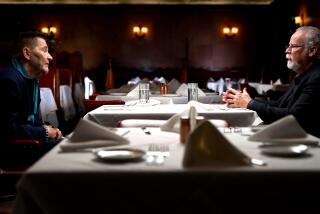New info scarce on VH1’s ‘Famous Crime Scene’
- Share via
Back when VH1 launched its “Behind the Music” series of rock documentaries in 1997, there were still musicians missing in action, stories left to excavate. It was conceivable that even an episode of that show about an extremely popular act would cough up stories that had managed to keep their way out of magazine profiles and radio interviews for years.
No more. Current celebrities have their every move documented on the Internet, either by their own choice or at the hands of fans and paparazzi. And stars of an earlier day are being dug up at alarming rates -- for reality shows, especially. It’s almost worth having gone away just to be afforded the chance to come back.
This change is largely thanks again to VH1, which has helped steer the movement toward total coverage over the last decade.
The result, though, is that the shock bar has been hopelessly raised. There’s practically nothing left to discover, and rehashing just doesn’t have the same punch. That’s the lesson of “Famous Crime Scene” (9 p.m. Fridays), a new VH1 series that began last month dedicated to revisiting the circumstances surrounding celebrity deaths.
Just revisiting, not reexamining: These episodes (there have been four) are merely bite-sized data dumps. By design, they’re coherent, pulling together a crisp story line. But by necessity, they’re incomplete, telling only the parts of the story that have been in the public record, and using the voices of only the people who were willing to show up and be interviewed.
The information on these episodes isn’t new. The innovation here is technology -- not crime-solving technology but crime-depiction technology. In each episode, there’s forensic animation illustrating how the death actually occurred. With Tupac Shakur and John Lennon, it’s the display of bullet trajectories. With Michael Jackson, it’s an illustration of how propofol works in the body. Rubbery and textbook-like, these are reenactments straight from “Bones” and “CSI.” Or more to the point, any number of true-crime reality shows that populate other basic cable networks.
There are also reenactments of the death scenes with look-alike actors, a tactic that works no better here than on “America’s Most Wanted.” In Anna Nicole Smith’s case, though, there’s at least one stroke of seemingly intentional salaciousness: she’s depicted topless, with breasts blurred out, as medics try to revive her with a defibrillator.
That’s what passes for titillation on this series, which is mainly sober and dry. As a compressor of received history, it occasionally shakes loose a tidbit worth remembering anew: for example, the home video in which Smith, clearly under the influence of something, has her face painted like a clown and speaks gibberish to the camera.
Suge Knight gives a characteristically evasive interview about Shakur’s death, and the police officer who helped carry Lennon into the hospital ER is a robust New York archetype.
But there’s no Howard K. Stern talking about Smith, no Yoko Ono speaking about Lennon. Instead, we get book authors (three of them in the case of Shakur), tabloid journalists, at least one paparazzo, and in the Lennon episode, then- New York City Mayor Ed Koch, all of whom threaten to serve the same function as the comedian talking heads on “I Love the 80s,” delivering facts as if they were hard-earned gems of wisdom.
Little mystery remains in these tales, and where it does, these episodes don’t bring any new information to the table. Of the first four episodes, only the murder of Shakur remains unsolved, which means only one episode even pretends to sustain tension. Otherwise, “Famous Crime Scene” is just a primer for a test to which everyone already knows the answer.
More to Read
The complete guide to home viewing
Get Screen Gab for everything about the TV shows and streaming movies everyone’s talking about.
You may occasionally receive promotional content from the Los Angeles Times.






